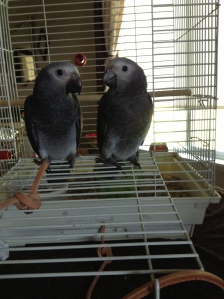Barking has been cropping up recently, so I thought I’d give it a go here.
There are three general types of barking: alarm barking, annoyance or nuisance barking, and play barking.
Alarm barking is what your dog does to let you know something’s wrong. Ideally, this is the type of barking we want. When someone comes to my door, Cash gives out several big, booming barks. He does this until I tell him I’ve heard him and I’ll take care of it. (I might say, “Enough,” or “it’s fine,” or “I got it,” or “Cash, knock it off,” depending on my mood. In every case, that’s his cue that I heard him and he can stop.) Note that he stops. That’s the big clue that your dog is alarm barking.
Alarm barking is really handy. It lets you know when someone’s at the door. It lets you know when a burglar is getting in. It lets you know when something unusual is happening — like a deer in the yard or a stray wandering about. It’s almost impossible to train a dog not to alarm bark, but you can train them that they shouldn’t be alarmed by things like squirrels, joggers, cars, etc, which they probably see all the time.
The more common type of barking is annoyance or nuisance barking. This is the barking that happens when someone’s at the door, and the dog won’t stop. It also happens for things they shouldn’t be alarmed about: squirrels, cars, joggers, etc. This can be annoying for family, friends, and neighbors, and it stops you from knowing when there is a problem. Remember the boy who cried wolf? Exactly.
Nuisance barking starts typically when a dog is just growing up. Around 8 months to a year of age, dogs would start exploring outside their little living area. They would see something new — “Oh my gosh! Those leaves are blowing!” — and bark to let the other dogs know. The other dogs would look at the leaves, look at the barking pup, and say, “You fool. Those are leaves. Knock it off.” In this way, the pup learns what actually is a problem, and what isn’t a problem.
We can do the same thing. When your dog enters his or her barking phase, there are various things you can do about it. In no particular order, you can:
- Let them drag a leash around, and tug on it when they start barking.
- Call them over and offer them a treat for coming, instead of reprimanding them for barking. (I find this has only limited usefulness.)
- Put pennies or rocks in a can or bottle (or a chain in a pillowcase) and make a loud noise when they bark, escalating to throwing the bag/bottle/can against the wall near your dog if you need to. (Don’t do this with highly anxious dogs.) (Just because your dog barks doesn’t mean they’re anxious. Most of the time, they aren’t.)
- Give them a quick poke after you’ve checked out the window.
- Go to where they are, make sure it’s nothing, then ask them to sit. Give them a treat for sitting. (I find this works much better than calling them, especially for answering the door.)
- Use a squirt bottle to squirt them when they bark.
Note that in each of these cases, you should see why your dog is barking, then tell them to stop, THEN act out the consequence/distraction.
This will teach them that they should bark at unusual things, but stop when you ask them to. If your dog persists at barking at normal things, then cut out the bit where you look at what they’re barking at, and just start fixing it as soon as they start barking. Interestingly, this makes for calmer dogs: even though they may get in trouble for barking, now they know that all those things in the world are no big deal, and they don’t need to grow into anxiety.
Finally, we have play barking. Play barking is what (mostly young and herding) dogs do when they want to play or want you to engage with them. Some of this is natural; if you’re playing with your dog and they’re barking, try not to worry about it. (If you HAVE to stop it because you live in a condo or something, then stop playing, wait for your dog to settle down, and start again.)
If, however, your dog is barking to get you to play and you can’t, then it’s time to break out the squirt bottle. Very seriously, tell them, “No,” or, “Not right now,” or, “I’m busy,” or, “Get a toy,” or anything you’d like to tell them. When they start barking again, do any of the following:
- Squirt them with a squirt bottle.
- Put them in time-out until they calm down in their crate or another room.
- Ask them to lay down and stay.
In each case, provide a more appropriate toy that they can entertain themselves with. Young dogs especially have to learn how to entertain themselves, and the way they do that is by you re-directing their energy to an appropriate thing.
In all barking situations, make sure you don’t get frustrated or raise your voice: if you do, your dog will think you’re barking back!
Now go, enjoy, and have a quiet household!
—————————-
Tango is now 13.5 weeks old, and taking his/her time weaning. That’s fine: it means s/he’ll be calm and confident when I do get him/her! These pictures are from last Friday. Tango and Quin, and Tango with his/her sibling!


Jenna